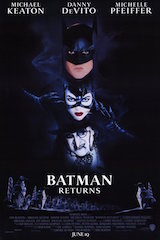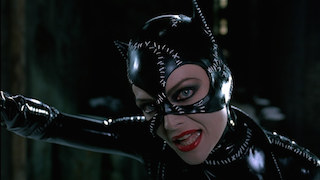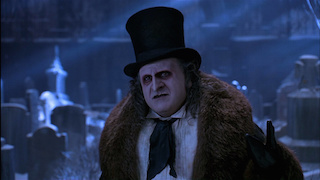 I have strange, sometimes conflicting, memories of Tim Burton’s Batman movies and Batman in general. The only exposure I ever received to the Caped Crusader as a child and young adults were the pre-Nolan movies and both the Adam West-starring TV Show and many iterations of cartoons. What were presented were two varying versions of Gotham’s shadowy hero.
I have strange, sometimes conflicting, memories of Tim Burton’s Batman movies and Batman in general. The only exposure I ever received to the Caped Crusader as a child and young adults were the pre-Nolan movies and both the Adam West-starring TV Show and many iterations of cartoons. What were presented were two varying versions of Gotham’s shadowy hero.
The first, and earliest, times I saw Batman was the Super Friends animated TV show on Cartoon Network and aforementioned camp-tastic live-action Batman TV show starring Adam West and Burt Ward. In those shows, Batman and Robin worked together and wore the more brightly colored, costume-y styles that often made them a bit sillier than what we have come to know. Between guest appearances in Scooby Doo on the animated side and countless absurd encounters with celebrities in the live-action show, my earliest memories of Batman were happy, kinda funny, and always littered with puns and witticisms.
The second version of Batman came as I got a little older. In fact, in retrospect, I’m not really sure how fans of the modern Batman put up with the older TV shows. Once a modern Batman made it to the big screen in 1989’s Batman, directed by Tim Burton, the campier and upbeat version of Batman gave way to a much darker, gothic place more fitting with the Dark Knight’s origins. Then, when I was ten, Batman: The Animated Series debuted and changed how I saw Batman even as a cartoon. Gone were the gray with blue shorts and boots. There were no crossovers with Scooby and the gang. The major influence for the cartoon was Tim Burton’s vision for Batman, but creators Bruce Timm and Erick Radomski managed to take the combination of noir, fantasy, and art deco, dubbed “dark deco”, and explore territory the movies couldn’t go that a TV show had time for. Combining these two major cultural milestones, the darker story elements, and noir imagery has survived as the dominant portrayal of Batman since the 90’s and what most of us 30 and 40 year-olds think of when we picture the Caped Crusader.
Coming off the major success of Batman, Tim Burton changed little of the aesthetic for the follow-up, 1992’s Batman Returns. The same noir elements permeate the opening moments of the movie. One of the major strengths of both Burton Batman movies is the wonderful German expressionist-inspired buildings. Harkening to a Russian style of architecture and incorporating elements of the clean, simple designs of fascist architecture, the city of Gotham never looked better than under the visual eye of Burton and production designer Bo Welch, who was a collaborator with Burton on Edward Scissorhands and Beetlejuice. And right from the opening, the stylistic touches of Burton permeate the introduction of Danny DeVito’s The Penguin.
In the opening moments, a couple, the Cobblepots, with Paul Reubens in a small cameo as Tucker Cobblepot, has a child in a gothic-style mansion, only to find their young boy is a monster, both physically deformed and mentally deranged. This young boy is unceremoniously dumped into the river, where it washes up in the underground of the abandoned Gotham Zoo and he is raised by penguins. It is revealed the young child is none other than The Penguin, Oswald Cobblepot, and when our villain finally appears as the leader of the Red Triangle Circus Gang, he has his sights set on blackmailing Gotham’s leading citizen, businessman Max Shreck, in order to become a citizen of Gotham and make his presence known.
 Meanwhile, Shreck’s secretary, Selina Kyle, knows the secrets of Shreck’s success and his new pet project, a power plant that will not supply power, but steal power from Gotham. When Shreck finds out, he pushes Selina out a window to her death. However, she survives and returns to her apartment, and reaching a mental breaking point, turns her vengeance and anger into an alter-ego, Catwoman.
Meanwhile, Shreck’s secretary, Selina Kyle, knows the secrets of Shreck’s success and his new pet project, a power plant that will not supply power, but steal power from Gotham. When Shreck finds out, he pushes Selina out a window to her death. However, she survives and returns to her apartment, and reaching a mental breaking point, turns her vengeance and anger into an alter-ego, Catwoman.
As this point, we’ve seen very little of Batman, and that may be one of my biggest complaints. It takes absolutely forever to Michael Keaton on-screen consistently. There is so much time within the first thirty to forty minutes devoted to unpacking, not just one, but two villains origins, it keeps Batman and Bruce Wayne sidelined for curiously long stretches.
However, once the character building has faded, and for a brief time in the second act, the movie’s brightest elements are shining. As Shreck looks to bypass the mayor and Bruce Wayne’s disapproval of his power plant by making new Gotham sensation, The Penguin, mayor of the city. All the while Catwoman plots her revenge and keeps encountering Batman. Michelle Pfeiffer seems perfectly at home in the skin-tight leather of Catwoman, and she prowls around Gotham with an unhinged determination to takedown Shreck. However, she is torn between her vengeful persona and her more docile, “house-broken” if you will, demeanor as Selina Kyle. And unbeknownst to both her and Bruce, both of their alternate personalities are smitten with the other. It comes to a head when Selina and Bruce are at a costume party and realize the other’s “mask”. Selina quips, “So are we supposed to start fighting, now?” It’s a delightful buildup that is punctuated both by their duty to their alternate, costumed egos, and equally delightful as their “costumes” are their normal, everyday personas as Selina and Bruce.
What I wish Burton had done with this movie was played down the awkward sexual undertones that permeate the movie on multiple levels. Bruce and Selina’s relationship are very straightforward, but Batman and Catwoman have a fierce, hands-y relationship that made for some uncomfortable moments. And then The Penguins overly awkward need to get grabby and hot-and-bothered by every woman in his path was unnerving. While I’m sure Burton tried for DeVito to give off an animalistic vibe to his attraction to the opposite sex, he just came across as a pervert. As Ebert put it in his review, his need for attention and recognition made him less of a connectable character and more of a pitiable one.
 In that same vein, the largest missteps of Batman Returns is the lack of connection to the characters, their greater plight of being cut off from normal society, and the ramifications of their own isolation. Batman and Catwoman cannot connect with normal people as Selina and Bruce, but we spend so little time with any of them, we’re unaware of how little their “masks” effect their ability to connect beyond sexual attraction. Whereas the later Nolan films would highlight Batman’s greater duty to Gotham, this movie gets bogged down in this relationship element at the cost of meditating on what it looks like to be a polarizing public crime fighter, a social pariah, and a misunderstood loner pushed to the breaking point.
In that same vein, the largest missteps of Batman Returns is the lack of connection to the characters, their greater plight of being cut off from normal society, and the ramifications of their own isolation. Batman and Catwoman cannot connect with normal people as Selina and Bruce, but we spend so little time with any of them, we’re unaware of how little their “masks” effect their ability to connect beyond sexual attraction. Whereas the later Nolan films would highlight Batman’s greater duty to Gotham, this movie gets bogged down in this relationship element at the cost of meditating on what it looks like to be a polarizing public crime fighter, a social pariah, and a misunderstood loner pushed to the breaking point.
Which is odd considering Burton was made to bring these characters to the big screen. He had so previously in Edward Scissorhands, Beetlejuice, and even in Pee Wee’s Big Adventure. All of these movies explored out-of-the-ordinary characters dealing with some form of social isolation as a result of being an outlier to the norm. The problem with Batman Returns is it reaches the same answers given in these other movies. Batman, unlike these others, is a heroic character who has come to terms with his isolation. Burton is unable to apply the heroic to Batman and Bruce Wayne, and he comes off as desperate and lonely since Vicki Vale was unwilling to be with him. Again, the Nolan movies do this much better, especially in The Dark Knight.
The one positive to this movie’s credit is the ending. Burton has Batman willing to give it all up to be with Selina, only to have that dream ripped away by Selina/Catwoman’s lust for revenge against the man who failed to kill her. It a surprising parallel to the end of The Dark Knight Rises, but in Nolan’s iteration, we see the dreamy, failed Knight of Cups test footage where Bruce and Selina live together in a tropical paradise. I’m sure many fans of Batman wish TDKR ended more like Batman Returns.
Overall, while many elements of the movie are done so well, other elements make this movie incredibly odd. Granted, my current filter is through the eyes of someone who is a big fan of Nolan’s movies. While Burton’s second Batman movie may remain as one of the only blockbusters to ever feel more like an art film than a real studio blockbuster, it fails to capture the heroic side of Batman and leaves fans of the Dark Knight pining for some sort of mashup between Nolan’s characterization and Burton’s aesthetic. I guess we’ll have to read the comics if we want that anytime soon.


